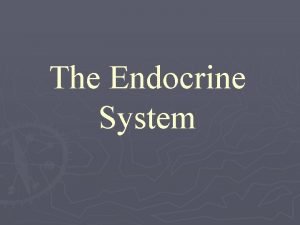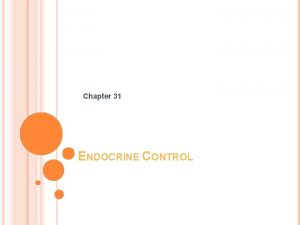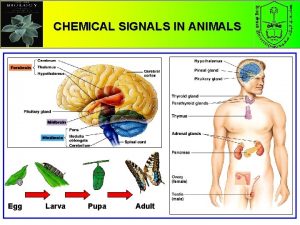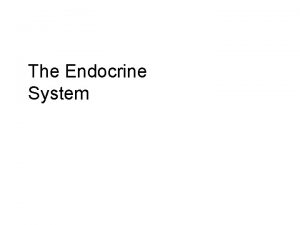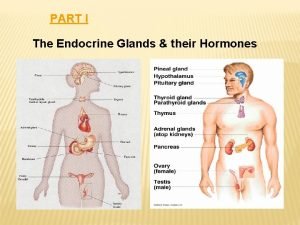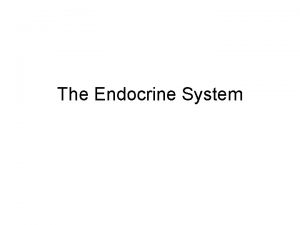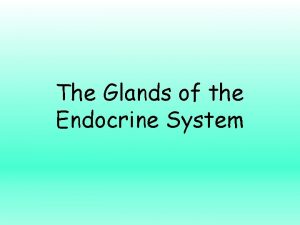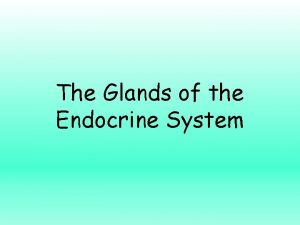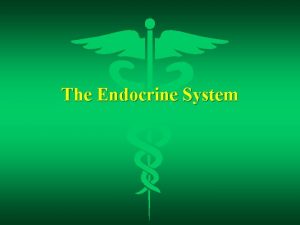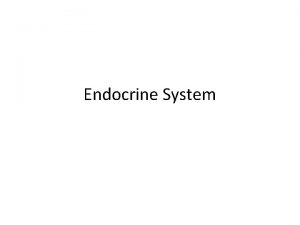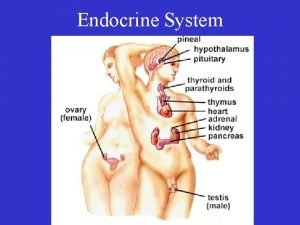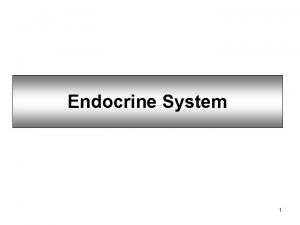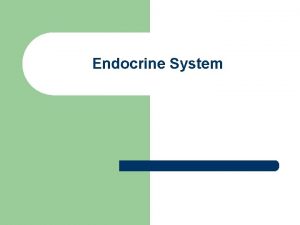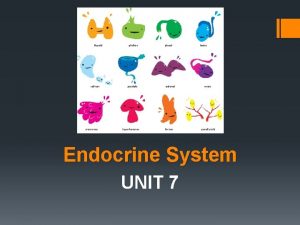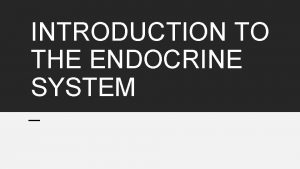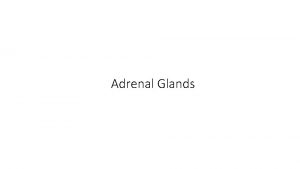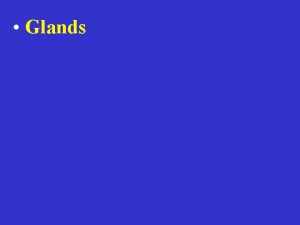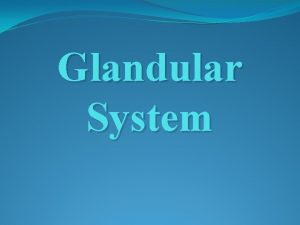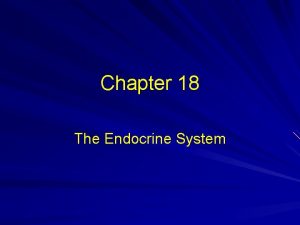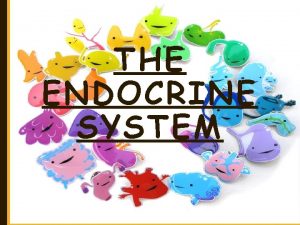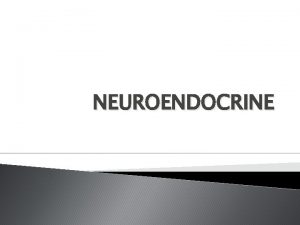Endocrine System Endocrine System Made up of glands





















- Slides: 21

Endocrine System

Endocrine System �Made up of glands that release hormones into the blood stream �Hormones – made of protein �Hormones travel to their effector (target tissue) which brings about a response

Endocrine System Explained �One of the body’s main system of communication �Uses glands at the pancreas, kidneys, gut, liver, nervous system, reproductive system, and even fat to control: Body energy Reproduction Growth / Development Homeostasis - How our body responds to the environment

Homeostasis �The body maintains a stable internal environment by controlling several important factors: Blood p. H Body temperature Blood CO₂ and O₂ concentrations Blood glucose level Water balance

Negative Feedback Mechanisms Essentially, negative feedback mechanisms are when the levels of a chemical lead to the reduction of the output/production



Negative Feedback Lingo � set-point: a constant value to which a variable is constrained, such that any time the variable fluctuates outside a given set -point range, negative feedback takes actions to return the variable to its set-point � sensors: sensors respond to stimuli, gathering information about a variable in question, signaling when its value fluctuates from the set-point � control center: receives information from sensors, comparing the value to a set-point, and if necessary, directing actions to return the variable to its set-point � effectors: a mechanism for taking action to return a variable to its set-point, switching on or off under the direction of the control center � responses: the resulting action produced by an effector, returning a variable to its set-point value

Homeostasis �In order for homeostasis to be maintained, it takes both the Nervous system and the Endocrine system working together �Yay teamwork!

Example 1: Body Temperature �body temperature: set-point: core body temperature = 37°C sensors: stimulus = body and blood temperatures above and below 37°C ▪ Hypothalamus - thermostat sensitivity to blood temperature ▪ skin warmth receptors ▪ skin cold receptors control center: ▪ hypothalamus - thermostat ▪ cerebral cortex

effectors: ▪ if T > 37°C (High Temps) 1. involuntary responses by sympathetic nervous system a. vasodilation => arterioles dilate sending more blood to the skin � increases heat loss b. decreased basal metabolic rate => decreases heat production c. sweating => increases heat loss d. lethargy => decreases heat production 2. voluntary responses directed by cerebral cortex a. rest => decreases heat production b. behavioral responses (fanning, change to cooler clothing, cool drink)

effectors: ▪ if T < 37°C (Low Temps) 1. involuntary responses by sympathetic nervous system a. vasoconstriction => narrowing of the arterioles, reducing blood flow � decreases heat loss b. increased basal metabolic rate => increases heat production c. shivering => increases heat production d. piloerection (goose bumps) => decreases heat loss 2. voluntary responses directed by cerebral cortex a. rest => decreases heat loss b. behavioral responses (muscular activity, change to warmer clothing, warm drink, curling up, eating

�response: if T < 37°C ▪ effectors: ▪ increase heat production ▪ decrease heat loss ▪ until T = 37°C if T > 37°C ▪ effectors: ▪ decrease heat production ▪ increase heat loss ▪ until T = 37°C

� Note the particular features of skin which are involved in temperature regulation: Hairs with the erector Pilli muscle Sweat glands Blood arterioles � The skin is an effector in the control of body temperature. � It is particularly important to prevent cooling or overheating of the core (essential organs and brain)


Homeostasis Example 2: Blood Glucose � set-point: blood glucose = 90 mg/100 ml � sensors: stimulus = blood glucose levels above and below 90 mg/100 ml glucose detectors in pancreas islet beta cells detect high glucose levels glucose detectors in pancreas islet alpha cells detect low glucose levels � control center: pancreas islet beta cells pancreas islet alpha cells � effectors: if blood glucose > 90 mg/100 ml, then pancreas beta cells produce and release insulin if blood glucose < 90 mg/100 ml, then pancreas alpha cells produce and release glucagon

�response: if blood glucose > 90 mg/100 ml 1. insulin binds to receptors in muscle and liver cell membranes 2. moving glucose from the blood into liver and muscle cells 3. where glucose is either metabolized or stored as glycogen or fatty acids 4. in fat cells, insulin promotes glucose entry where it is converted to triglycerides 5. until blood glucose = 90 mg/100 ml if blood glucose < 90 mg/100 ml 1. glucagon binds to receptors in liver cell membranes 2. which activates a cascade of enzymes which degrade glycogen into glucose 3. glucose moves from the liver into the blood 4. until blood glucose = 90 mg/100 ml


Blood Sugar Balance �Blood sugar concentration is regulated for a number of reason amongst which: Osmosis. content of a tissue is determined by the concentration of the surrounding tissues. Respiration: Some tissues are entirely dependent on blood sugar as a respiratory substrate being unable to either store glucose of metabolize fat

Diabetes Mellitus �The control of blood glucose doesn’t work effectively so the concentration can rise or fall beyond normal limits �Two Forms Type II

Diabetes Mellitus TYPE II Typically childhood onset α cells produce insufficient insulin Cannot be controlled by diet Treatments always revolve around injections Typically onset is after childhood Target cells become insensitive to insulin Lifestyle changes can be used for treatment Weight loss, change in diet Insulin injections not usually needed initially
 Endocrine glands
Endocrine glands Merocrine glands vs apocrine glands
Merocrine glands vs apocrine glands Major endocrine glands male and female
Major endocrine glands male and female Chapter 16
Chapter 16 Difference between endocrine and exocrine glands
Difference between endocrine and exocrine glands Endocrine and nervous system comparison
Endocrine and nervous system comparison Thyroid follicle histology
Thyroid follicle histology Whats the difference between endocrine and exocrine glands
Whats the difference between endocrine and exocrine glands Hypothal
Hypothal Endocrine glands
Endocrine glands What are chemical signals
What are chemical signals Endocrine glands
Endocrine glands Hyophysis
Hyophysis Endocrine system of rat
Endocrine system of rat Endocrine system and reproductive system
Endocrine system and reproductive system Endocrine system vs nervous system
Endocrine system vs nervous system Lymphatic system vs endocrine system
Lymphatic system vs endocrine system Endocrine vs nervous system venn diagram
Endocrine vs nervous system venn diagram Endocrine system and nervous system
Endocrine system and nervous system Cutaneous membrane
Cutaneous membrane Adenohypophysis
Adenohypophysis Sympathetic nervous system
Sympathetic nervous system


